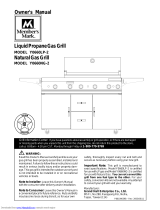
20
Guide to Rotisserie Cooking with The Back Burner
Guide to Using The Smoker Drawer
Rotisserie Cooking
Rotisserie cooking produces foods that are moist,
flavorful and attractive. The optional rotisserie system
is most commonly used for cooking meat or poultry
and is designed to cook food from the back burner
using infrared heat. The location of the burner allows
the placement of a cooking pan beneath the food to
collect juices for basting and gravy. To flavor the
contents of the cooking pan you may add herbs,
onions, or other spices of your choice. The back burner
is an infrared type, which provides intense searing
radiant heat. The intense heat sears in the natural
juices and nutrients found in quality cuts of meat.
The cooking times on a rotisserie will be approximately
the same as for oven cooking.
Balancing the Food
In rotisserie cooking, balancing the food is of utmost
importance. The rotisserie must turn evenly or the
stopping and starting action will cause the food to cook
unevenly and possibly burn the heavier side.
The easiest foods to balance are those of uniform
shape and texture. To test if the food is balanced
correctly when secured, place the ends of the rotis-
serie spit loosely in the palms of your hands. If there is
no tendency to roll, give the spit a quarter turn. If it is
still stable, give it a final quarter turn. It should rest
without turning in each of these positions. It can then
be attached to your grill.
Food Preparation
When preparing poultry, truss the birds tightly so that
wings and drumsticks are close to the body of the
bird. The cavity of the bird may be stuffed prior to this.
Pull the neck skin down and, using a small skewer, fix
it to the back of the bird. Push the rotisserie spit
through lengthwise, catching the bird in the fork of the
wishbone. Center the bird and tighten with the holding
forks. Test the balance as described before.
A rolled piece of meat requires the rotisserie skewer to
be inserted through the center of the length of meat,
then secured and balanced.
For meats that contain bones, it is best to secure the
rotisserie skewer diagonally through the meaty
sections. If protruding bones or wings brown too
quickly, cover with pieces of foil.
Tips for Using The Back Burner
For back burner lighting instructions refer to page 10 of
this Owner's Manual.
The location of the back burner makes it more suscep-
tible to winds that will decrease the performance of
your rotisserie cooking. For this reason you should not
operate the back burner during windy weather
conditions.
For best results, always rotisserie cook with the grill
lid down and the Back Burner control knob set to
HIGH. Do not use the main grill burners when the
Back Burner is in operation.
Preparing to Smoke
Smoking gives food a distinctive, delicious flavor. You
will find a variety of wood chips or pellets available for
use in smoking grilled foods. Pre-soaking of wood
chips may be required so read and follow the manufac-
turers instructions for preparation of smoking chips
prior to filling the smoker drawer.
Using The Smoker Drawer
Start your grill and allow it to reach the desired cooking
temperature for the food you are grilling. Wear an
insulated cooking glove and pull the smoker drawer out
of the grill and fill with your prepared smoking chips.
Dried herbs and spices may also be added to produce
different flavors. Return the smoker drawer to the grill,
ignite the smoker drawer burner See
instructions on Page 11, the heat will produce smoke
and season the food.
Tips for Smoking
You can reduce the strength of the smoke flavor by
only smoking for half or three quarters of the cooking
time. The heat required for smoking is normally low to
medium.
Foods naturally high in oils lend themselves well to
smoking, while drier foods benefit from a marinade.
You can also rub the food with herbs, spices or
flavored oils. Many foods can be smoked to produce
stunning results with very little effort. Here are a few
suggestions:
Chicken, boneless chicken piecesespecially
sliced breasts
Fish, sliced fillets of firm fish, assorted seafood
such as prawns, scallops and calamari
Pork, sliced fillets, diced or minced pork, sliced
leg steak, sliced chops
Beef, sliced fillet, rib-eye, round, rump, sirloin
Lamb, sliced fillet, round, loin
Tuna steaks, marinated in Asian flavors of sesame
oil, soy sauce and sherry.
Pork fillets, rubbed with ginger, orange rind and
brushed with maple syrup.
Mussels, brushed with lemon rind and chili oil.
Lamb cutlets, marinated in virgin olive oil, lemon,
oregano and black pepper. The same marinade can
be used for a whole leg or rack of lamb.
Downloaded from www.Manualslib.com manuals search engine






















